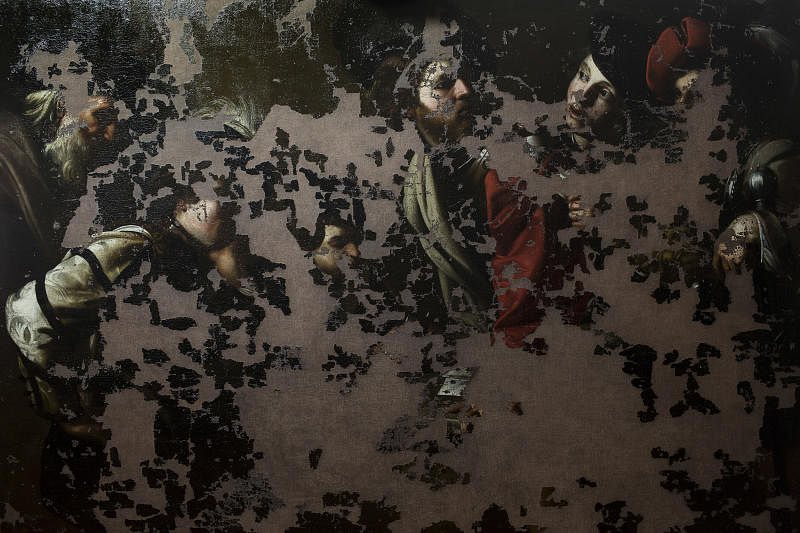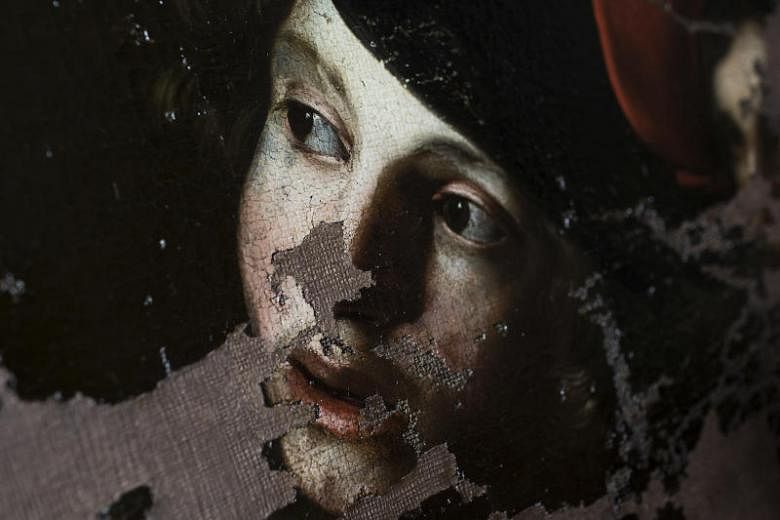FLORENCE, Italy (NYTIMES) - Four years ago, a Florentine restorer happened upon a painting fragment peeking out of an envelope stored in a depository at the city's famed museum, the Uffizi Gallery. It depicted part of a six of spades.
"I used to play cards with my dad and his friends," the restorer, Daniela Lippi, 49, recalled. "That small detail meant something to me right away." The piece was from "The Card Players" by Bartolomeo Manfredi, an early 17th-century follower of Caravaggio.
The painting had been shredded in a 1993 Mafia bombing in the centre of Florence that damaged hundreds of artworks at the Uffizi. It had been deemed unrestorable. The 615 canvas scraps that could be recovered had been set aside.
On Saturday (May 26), after months of crowdfunding efforts in Florence, and 10 months of arduous restoration by Lippi, the painting will be displayed at the Uffizi for the first time since that attack, which killed five residents and wounded dozens, in addition to damaging historic buildings. It is the last of the damaged works to be restored.
When Lippi opened the envelope she discovered four years ago, the hundreds of painting fragments were still covered with the translucent, Japanese rice paper custodians had used in 1993 to preserve them.
She realised that at least some of the players' faces could be brought back to life, and decided to undertake a laborious restoration.
Her efforts were aided in 2017, when, with the 25th anniversary of the attack approaching, a local paper began a crowdfunding drive. The publicity campaign used the disfigured face of a player from the painting, and the effort quickly caught on, surpassing its goal and raising 26,000 euros (S$40,720) in all.
PAINSTAKING RESTORATION
The city's institutions were also determined to use the campaign to keep the memory of the attack alive and to remind residents that they still needed to fight back against Mafia terrorism.
"For Florence, Italy, and the world, it was such an important event of terror," said Eike Schmidt, director of the Uffizi. "We can't bring back to life the people left dead, or the heavily damaged paintings. But we can build a memorial for culture against violence and terror." The Uffizi Gallery gave permission for the restoration, the Scala Archives donated a large photo of the original from which Lippi could work, and a group of professional restorers helped her.

"It was in such condition that I knew I couldn't bring it back to its original perfection," Lippi said recently, as she applied the finishing touches to the painting in her Florentine laboratory, magnifying glasses on her eyes and a brush in hand.
For 10 months, mixing digital imagery, modern scanning technology, and old-school colour recognition, she learned the painter's most intimate touches by heart.
The 615 fragments amounted to a precious and delicate jigsaw puzzle.
Of them, 500 were cleaned, sewn together and then glued onto a new canvas, forming an imperfect portrait of men dressed in elaborate clothes playing zarro, a betting game popular in the 1500s. The other pieces - too small or damaged to be used - will be preserved.
"The missing pieces are important, to show what happened to it," Lippi said, referring to the new sand-coloured stucco she has treated to look like a 17th-century canvas. "This painting is the living memory of the attack 25 years ago."
While Lippi was working, a team of documentary filmmakers recorded her effort. They also launched their own fundraising drive, called "The Care", to show what it took to care for the painting.
"This is not just a restored painting," Luca Galassi, one of the documentary makers, said. "It's a symbol of strength and rebirth of a community still years on."
For the coming week, the Uffizi will host an immersive installation that will allow visitors to relive that night - May 27, 1993 - when a blast close to the museum reverberated through the narrow medieval streets and arches.
A quarter of the Uffizi's artworks suffered damage. Paintings were cut by flying glass, ancient statues were mutilated, and vast cracks opened in the museum walls overlooking the street where a Sicilian mobster had detonated a Fiat van loaded with more than 270kg of explosives at 1am on a Wednesday.
RETALIATION
Decades later, judges established that the attack was part of a strategy by the Sicilian Mafia to hit landmarks in retaliation for the government's imposition of strict rules, including isolation, against jailed Mafiosi.
Most Florentines clearly remember that night. Some recall the detonation, which could be heard from miles away, and others the potent shock wave it caused. The explosion left a deep crater where the Fiat had been parked, hidden from view near the gallery. The detonation was so violent the asphalt was pulverised into rocks and sand; a piece of the van was found across the river.

Rescuers recall hundreds of dumbfounded residents coming out on the streets. It took hours before Florentines realised that it was a car bomb. The early-morning news still spoke of a possible gas tank explosion.
It was around 6am that day that firefighters walked into the Uffizi Gallery with the museum's curators, recalled Maurizio Maleci, a fire official who filmed the aftermath.
There was total darkness. The outer gate looked intact, he recalled, but as they walked deeper into the corridors, they could hear the sound of broken glass crunching underfoot.
"I am Florentine, I had seen the Uffizi so many times," Maleci said. "But the paintings there no longer existed, the city had been struck at the heart." "The Card Players" was scattered in tiny fragments around the floor, he said. A nearby canvas was torn apart.
In a neoclassical room, portions of the stucco fell from the ornate barrel-vaulted roof and an ancient Greek sculpture had its legs cut off from the window glass and wooden frame.
"The devastation was such that I thought we had lost them," Maleci said. His voice cracking, he remembered the small kindnesses of Florentines, who offered firefighters coffee as they laboured over the rubble.
In the following weeks, Florence fought back. The museum personnel searched the floors on their knees, separating the plaster and bricks from pieces of canvas and marble, and gently collected them in wooden trays.
The paintings that suffered the heaviest damage were from the Caravaggio school, whose iconic colours were dark. Determining which fragment belonged to which painting proved to be an enormous task, officials remembered.
Parts of the Uffizi reopened just 20 days later, but while it was shut other museums opened extra hours to offer visitors the city's best face.
"Younger generations don't know much about those bloody years," said Schmidt, the Uffizi director. "This is also for them to know that the Mafia still exists, and it's a risk we need to reckon with."



